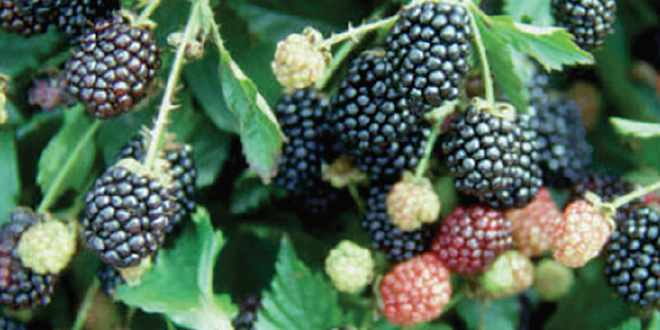
May 20, 2020Blackberry stakeholders surveyed about challenges, needs
What does the blackberry industry need? A grant from the USDA Specialty Crops Research Initiative brought together 20 academic researchers and Extension specialists and 18 growers and industry representatives to discuss this question in a two-day strategic planning meeting for the blackberry industry immediately after the North American Raspberry & Blackberry Association conference in St. Louis, on March 6 and 7.
As part of the project, a national survey of blackberry stakeholders was conducted to find out what growers – and other stakeholders such as Extension, researchers and marketers – felt were the main needs and priorities of the blackberry industry. “The most recent comprehensive survey of blackberry production and practices was conducted 15 years ago,” said project leader Margaret Worthington, fruit breeder at the University of Arkansas. “Production statistics and assessments of stakeholder priorities were fragmented and out of date, not reflecting new challenges and opportunities for the blackberry industry. Therefore, we felt an updated survey and needs assessment of the U.S. blackberry industry was desperately needed.”
A total of 174 survey responses from 33 states were received. Labor availability was identified as the most important concern in all regions and the greatest limiting factor to the growth and profitability of the U.S. blackberry industry. Labor cost was also a major issue in most regions. Across all regions, spotted wing drosophila was the highest priority pest and disease issue. Weed control was the highest priority cultural problem in all regions except California (where most production is under tunnels), while red drupelet reversion, white drupelet, winter injury and rain during harvest were high priorities in some areas.
Asked to report complaints from consumers and grocers, flavor was mentioned most often. In the individual comments collected by the survey, one West Coast respondent commented, “We do not have a demand problem; we have a product quality program. Flavor, red cell, poor post-harvest handling, etc., which means the consumer is getting inconsistent quality and satisfaction from our industry. They will buy a consistently good product but right now there is too much variability in the product.” Another from the East Coast echoed the same sentiment: “Ensuring the consumer gets consistent, pleasing flavors for the entire supply season would ensure even more consistent purchase … (though) fruit quality across the board is much, much higher than past years.”
More than two-thirds of respondents felt that investment in health benefits research would make selling blackberries easier (versus other berries or fruits) and lead to greater sales volume; they were less convinced it would justify charging higher prices and lead to greater profitability.
“The strategic planning meeting was a great opportunity for blackberry growers, researchers, and Extension specialists from different parts of the country to put our heads together,” Worthington said. While many ideas emerged from the discussions at the meeting, flavor, postharvest quality, and labor issues were identified as the most important constraints to the growth of the U.S. blackberry industry. And, the top national research priorities identified were control of spotted wing drosophila and breeding for improved flavor, firmness, and disease resistance.
The next goal for the project team, said Worthington, is to use the stakeholder input and the directions that emerged at the meeting to develop an interdisciplinary research and extension project that will increase the profitability and sustainability of the U.S. blackberry industry.
— Debby Wechsler, FGN correspondent














